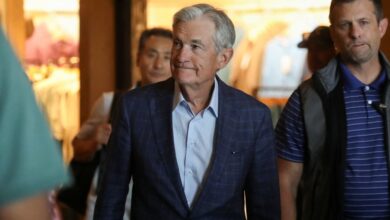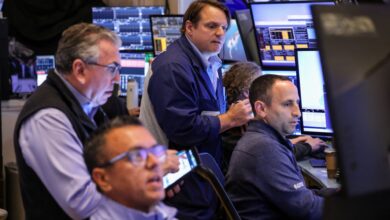Markets are sure the Fed will cut in September, but the path from there is much murkier

Traders work on the floor of the New York Stock Exchange on Aug. 22, 2025, in New York City.
Spencer Platt | Getty Images
Friday’s booming rally turned into Monday’s reality check as investors weighed just how aggressive the Federal Reserve will be on lowering interest rates and how the moves might impact the broader business and economic climate.
Chair Jerome Powell, in his annual address at the Jackson Hole, Wyoming, symposium, gave Wall Street hope of easier days ahead when he said conditions “may warrant adjusting our policy stance,” which is generally seen as “Fedspeak” for cutting rates.
Stocks soared while Treasury yields plummeted on the news as the knee-jerk reaction took hold for a rate reduction when the Federal Open Market Committee issues its next decision on Sept. 17.
However, cheer turned to caution Monday as market experts weighed what happens next, even if a move next month is baked in. Stocks were mostly lower and shorter-maturing Treasury yields, which are more sensitive to Fed action, moved higher.
“I’m on the slower side more than the faster side if the Fed, does go,” said Jason Granet, chief investment officer at BNY. “He definitely moved the door ajar, as opposed to kicked it wide open for September.”
Traders on Monday were pricing in a near-certainty of a September quarter percentage point reduction from the Fed’s current target rate, currently around 4.3%. The implied probability of 82% was only slightly higher than a week ago but well above the 62% odds of a month ago, according to the CME Group’s FedWatch measure of futures prices.
However, there is less certainty from there.
Potential slow pace ahead
The implied probability for another cut in October was just 42%. That second cut is about fully priced in for December, but there’s just a 33% expectation for three total moves this year.
“I think there’s more to play for in the data between now and the September meeting,” Granet said. “So then the question will start to center around pace.”
Skeptics of a faster easing pace center their arguments around ongoing concerns about tariff-induced inflation and an economy that is holding up despite signs that the labor market is slowing.
“Although we are aware of the extreme political pressures on the Fed to ease, and we acknowledge cracks emerging in some labor market data, from our perch … the case for cuts looks modest,” Lisa Shalett, chief investment officer at Morgan Stanley, said in a note. “And we can’t help but ask — what problem, exactly, does the Fed feel an urgency to solve?”
Despite the market pricing, Morgan Stanley sees just a 50% probability for a September reduction. The firm also cited uncertainty about inflation as well as the Fed’s commitment to independence amid the heat from President Donald Trump and White House officials to lower rates.
Shalett also cautioned clients about putting too much faith in Fed easing for the next leg up in stocks as “we question the impact of rate cuts in any case, given the reality that absent recession, an easing cycle is apt to be shallow while the interest rate sensitivity of the biggest economic agents has meaningfully declined.”
Worries over a repeat of 2024
Indeed, there are ongoing questions about the impact of Fed rates in the current climate.
At this time a year ago, the central bank entered an easing mode that ended up having unintended consequences — an inverse move in Treasury yields and mortgage rates pushed by worries that the Fed might be taking its foot off the brake too soon along with expectations for stronger economic growth.
That’s the kind of consideration that has market veteran Ed Yardeni wondering about the wisdom of another round of cuts as he worries that Powell might be wrong about the temporary impulse of inflation from Trump’s tariffs.
“The Fed won’t listen to me. Of course, they’ll do what they’re going to do,” the head of Yardeni Research said Monday on CNBC. “The cautious tale is what happened last year when the Fed lowered by 100 basis points and the bond yield went up 100 basis points.”
Should that happen again, it would thwart the White House’s hopes for lower financing costs on the national debt and a boost for the housing market through lower mortgage rates.
On the bright side, though, Yardeni thinks the equity market rally will get a boost from rate cuts, and he is maintaining his bullish view on stocks even in the face of a potential policy mistake. Yardeni thinks the S&P 500 could add another 2% from here to close the year around 6,600, then climb another 14% in 2026 to close at 7,500.
“I think we’re going to have a continuation of the bull market, but I think it’s going to be earnings led,” he said. “If the Fed does go ahead and lower rates on Sept. 17, I think my targets may be too conservative right now.”




